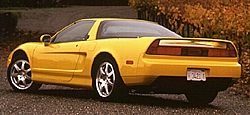 |
 |

OVERVIEW
A rigid structure is of paramount importance in a performance car. High rigidity provides a stable platform for proper suspension geometry and alignment, and it makes possible a tight, rattle-free interior. Additionally, central to the goal of performance is a favorable power-to-weight ratio, which has been improved by 30 percent with the new 3.2-liter V-6. As a rule, a very light car can achieve high performance levels with less horsepower. After an intensive research effort, it was determined that the most efficient way to meet the rigidity and weight targets for the NSX was to build the car exclusively of aluminum.Using a Cray supercomputer, the engineers performed millions of Finite Element Modeling (FEM) and stress analysis calculations. The result of this research and development effort is a chassis that weighs 210 Kg (462 lbs) with doors, hood and deck lids installed--about 40% less than a steel chassis, but with the same rigidity and impact protection. The NSX structure is significantly stiffer than every other competitor currently on the market. Both models, the NSX and the removable-top NSX-T. meet 1997 federal side-impact standards.
To counter the small weight increase of the new G-speed transmission and larger brakes, key body parts are now made with a newly developed 6000 series aluminum alloy that is up to 50 percent stronger, thus requiring less material to perform effectively. This thinner, lighter-weight new material is used in making the doors, fenders, and front and rear deck lids, among other key parts of the NSX. For example, by using this high-strength alloy, thinner doorskin material netted a 2.2 kg (4.9 lbs.) weight reduction without any sacrifice in strength.
BODY REINFORCEMENTS
To maintain high rigidity in the body, even with the roof panel of the NSX-T removed, extensive reinforcement measures are employed throughout the body. Required reinforcement include side sill aluminum extrusion design that involves significantly thicker wall sections. Other areas include the base of the B-pillar where it joins the rocker panel, a larger rear bulkhead crossbar, a thicker trunk leading edge panel, a reinforcement web in the rear floor cross member, an additional rib in the center rear bulkhead section, a redesigned and thicker walled rear roof rail section, a redesigned front roof rail section with increased wall thickness, a completely redesigned and thicker upper A-pillar, a redesigned and thicker upper dashboard crossmember, and a redesigned front lower floor section with increased wall thickness.REMOVABLE TOP
The removable top is made of aluminum for light weight and durability. The roof panel is body-colored and is easily removed by means of two latches located on the left and right side. Its light 8.5 kg makes it easy to remove and stow away. A dash indicator light alerts the driver if the latches are not properly closed. Once removed, the panel is stored under the rear glass hatch and the hatch can be locked with a key for security. Since the top has its own storage compartment, it doesn't use any of the available trunk or interior space. In addition, the vehicle security system functions with the top removed as well as in place.EXTRUDED ALUMINUM SIDE SILLS
To attain a structure of high rigidity, complex aluminum extrusions were used for the crucial side sills of the unit body. These extrusions, with their carefully braced internal structure, contribute to the extremely high torsional stiffness of the NSX.RADIUSED FRONT FRAME RAILS
To maximize occupant protection, the front frame rails of the unit body are designed with large-radius curves where they meet the passenger cabin. This design helps to dissipate energy in the event of a collision, spreading out impact loads and diverting them under the passenger cell.
![[email image]](../Graphics/email.gif)
Last modified 2/3/97. Copyright ©1996, 1997 by AUTOPEDIA, all rights reserved. AUTOPEDIA™, AUTO411™, CAR-IQ™, DEALERPEDIA™, INTERLOT™, SIMULSEARCH™ and INTERQUOTE-RFP™ are trademarks of AUTOPEDIA. All other trademarks, tradenames and/or service marks are the property of their respective holders. Although all information and prices contained herein are obtained from sources deemed to be reliable, AUTOPEDIA assumes no responsibility for the accuracy of the information and no liability for any errors and/or omissions. All information is subject to change without notice.